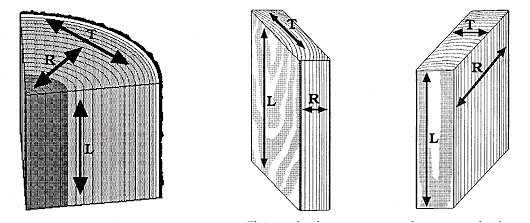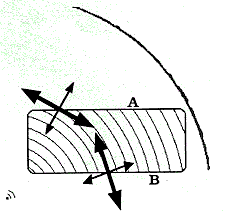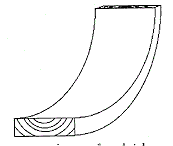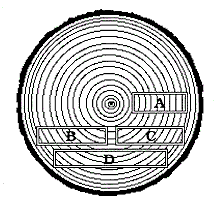Forestry Facts
School of Natural Resources
Department of Forestry
No. 68 - November 1993
Causes and Cures for Warp in Drying
Eugene M. Wengert and Dan Meyer
Lumber warps in many different ways, but all warp is caused by differential directional shrinkage as the wood dries from its green state. When one edge or face or end of a piece of wood shrinks more than the opposite edge or face or end, the piece warps. The three types of warp are cup, bow and crook. Following an introduction to wood shrinkage, each type of warp will be discussed in terms of its causes, likely locations in a log from which lumber might suffer from it, and preventative measures which can alleviate the warping problem, where possible.
Wood Shrinkage
Wood shrinks in all of its three directions--longitudinal, radial and tangential (Figure 1)--as its moisture content changes. Wood shrinks the least in the longitudinal direction, or along the grain. Wood from the juvenile core, the wood closest to the center of the tree, shrinks more longitudinally than does more mature wood. Tension and compression wood tend to amplify longitudinal shrinkage. When going from green (wet) to kiln-dried, mature wood will shrink less than 0.1% along the grain. Thus, a 10-foot green piece of lumber will lose less than 1/8-inch in total length when dried. For most species, longitudinal shrinkage is so small that it is of no concern.
Radial shrinkage is shrinkage in the direction from the center of the tree to the bark (Figure 1). Radial shrinkage in North American species ranges from 4 to 6 percent. A 2-inch thick, wet, flatsawn piece of lumber, when dried, will thus lose up to 1/8-inch in thickness due to shrinkage.

| Flatsawn lumber | Quartersawn lumber |
Figure 1. Shrinkage directions in wood: L--Longitudinal; R=Radial; T=Tangential.
Tangential shrinkage is directly perpendicular to radial shrinkage and roughly double in magnitude. For North American species, tangential shrinkage ranges between 6 and 12 percent. A flatsawn 6-inch wide board, when dried, could shrink in width as much as 3/4-inch.

Figure 2. For purposes of clarity, herein, the different surfaces of lumber are referred to as the ends, edges and faces, without regards to grain pattern.
Causes and Cures for Warp
Cup
Cup is warp across the width of the face of a piece of lumber. It occurs when one face shrinks more in width than the opposite face. The end becomes cup shaped (Figure 3).

Figure 3. End view of a cupped, flatsawn board.
For true quartersawn lumber (ring pattern is symmetrical), both faces will shrink evenly, and cup will not occur. For any other grain pattern, the outer face (that which faced away from the center of the tree) will shrink more than the other face, causing the board to cup towards the outer face.
Figure 4 shows the location of the lumber with respect to its location in the tree. The heavy, longer arrows represent shrinkage in the tangential direction, while the lighter, shorter arrows are the direction of radial shrinkage. Shrinkage along surface A is more in the tangential direction than in the radial direction (i.e. surface A is more closely aligned with the dark arrow). Along surface B the shrinkage is mostly radial (surface B is closely aligned with the lighter arrow). Because wood shrinks nearly twice as much in the tangential direction as the radial direction, surface A will shrink more than surface B, causing the lumber to cup towards surface A. This is always the case: lumber cups away from the center of the tree, or towards the bark.

Figure 4. Radial and tangential shrinkage directions in relation to the board's original position in the tree. The large arrows represent shrinkage in the tangential direction; the small represent radial shrinkage. A = bark face, or sap face; B = heart face.
Several factors can influence the severity of cup in lumber. The difference in shrinkage between the faces is greater as the lumber approaches a perfectly flatsawn piece. It is also greater when the lumber is sawn from areas closer to the center of the log. (Note: With smaller logs, a greater percentage of the lumber is close to the center of the tree. Hence, small timber has a greater tendency to result in more cupped lumber.) Also, there is a variation in cup among species due to differences in tangential and radial shrinkage rates--the greater the ratio between tangential and radial shrinkage values (percent), the greater the tendency to cup.
Cures for Cup
Cup can be prevented, or at least minimized, with careful handling procedures. There is little hard evidence that closer sticker spacing or better sticker alignment in stacking will reduce cup, yet these practices will certainly not promote cup, and they are beneficial in reducing other types of warp. Placing heavy weights on a stacked lumber pile can be beneficial in preventing cup, but the load required is at least 150 pounds per square foot and it must remain on top of the pile for three days after drying is complete. Finally, in stacking, avoid, as best as possible, placing lumber with different thickness variations in the same layer. The thinner lumber, even if only a fraction thinner than the thickest lumber, is not held tightly flat by the stickers and is prone to cupping.
When drying lumber in the predryer or kiln, follow correct practices, as they reduce cupping:
-- Do not allow partially dried lumber to inadvertently regain moisture quickly;
-- Do not dry lumber too slowly;
-- Do not over-dry lumber (even if equalizing is used to bring up the moisture level at the end of drying)
Bow
Bow is warp along the length of the face of lumber. It occurs when one face of lumber shrinks more in length than the other. It causes the lengthwise curvature of a piece of lumber such that it resembles a bow used in archery (Figure 5).

Figure 5. Bow occurs when one face shrinks more longitudinally than the other. The board will bow towards the center of the tree.
Wood does not normally shrink along the grain by any appreciable amount. Hence, bow due to wood characteristics is a rare event. However, wood close to the center of a tree (within 20 years of the center) does shrink more along the grain than more mature wood. So, it is possible to have either a flatsawn or a quartersawn piece of lumber that has mostly wood from the juvenile core on the heart side and mostly mature wood on the bark side. The juvenile side will exhibit longitudinal shrinkage, causing the lumber to try to bow excessively during drying. Most pieces that show this characteristic would be No. 2 Common or below in grade, as they are typically close to the center of the tree.
It is also possible to get longitudinal shrinkage in a piece of lumber sawn from a crooked log or in wood around a large branch. The wood cells in the resulting lumber are oriented at an angle, causing longitudinal shrinkage and a tendency to bow.
Cures for Bow
Consistency in sawmilling can alleviate some bow problems. Lumber should be of uniform thickness. Improper saw feed speeds or lapses in saw maintenance can result in lumber that is thinner on the ends than in the middle. This leads to a type of bow. called "pile bend," which appears in the upper layers of a pack.
Proper and timely handling and drying of lumber will also help to reduce or eliminate bow. Wood that is wet and warm can bend quite easily. In fact, the shrinkage, or bending, that causes warp usually occurs at high MCs (above 40% MC).
Make sure the stacking procedure itself is not contributing to bow. The 4x4s and stickers must be of uniform thickness. Careful stickering practices, such as maintaining good vertical alignment and assuring no stickers are up on edge, are a "must" for flat lumber. Foundations for green lumber piles, whether in the kiln, predryer or air-drying yard, must be flat.
Certain drying procedures should also be avoided. especially at high MCs, as, once warp occurs at the higher MCs, it is difficult, if not impossible, to straighten the lumber in the kiln at low MCs, no matter what kiln-drying procedures are used. Drying wood too slowly will exacerbate bow. Fast drying, especially at high MCs, can reduce the amount of bow, but fast drying with a species such as oak results in checks and honeycomb.
Likewise, rewetting partially dried lumber will increase the MC of the surface fibers and allow the shrinkage stresses in the wood to more easily bend the lumber. (Note that lumber can be rewetted inadvertently in several ways: using higher than required kiln relative humidities (RH), perhaps in an effort to dry cautiously; an accidental discharge of the fire sprinklers; starting a kiln with steam spray before reaching required dry-bulb temperature; or because the load of lumber has widely varying initial MCs, meaning that the high RH used to protect the wet lumber is actually rewetting the drier lumber.)
Crook
Crook, or side bend, is warp along the length of the edge of lumber. It occurs when one edge shrinks more in length than the other. It causes the edgewise curvature of a piece of lumber (Figure 6). As lumber does not normally shrink along the grain, crook, like bow, is an abnormal event caused by shrinkage of "abnormal" wood in the lumber.

Figure 6. (Face view) Crook occurs when one edge shrinks more, longitudinally, than the other. The board will bend towards the edge closest to the Juvenile core.
There are several types and grain patterns of wood which have the characteristic of shrinking along the grain, including wood from the juvenile core, compression wood, tension wood, sloped grain and cross grain. If this special wood is distributed evenly throughout the piece of lumber, longitudinal shrinkage, and therefore warp, is not a problem. The special wood becomes a problem when it is on one edge and not the other.
The biggest factor influencing the degree of crook in a piece of lumber is its original location within the log. Perfectly flatsawn lumber (Piece D, Figure 7) is unlikely to experience crook because both edges were equidistant from the tree's core, and thus should experience the same magnitude of longitudinal shrinkage. On the other hand, quartersawn lumber is the most susceptible to crook, as one edge is closer to the center of the tree, and this edge is more likely to consist of wood from the juvenile core, than the other edge (Piece A, Figure 7). When two boards (such as pieces B and C) are ripped from a wide, flatsawn board (such as Piece D), they become susceptible to crook during drying even though the original wide board (D) was not susceptible. The rings of the smaller boards are "off-center," indicating that one edge is closer to the tree's juvenile core.
Cures for Crook
First and foremost, use a sawing pattern which keeps the rings centered, from edge-to-edge, within the lumber. Usually this means that after sawing one face of the log, the opposite face should be sawn next (that is, the log should be turned 180°). Because the rings are centered, any longitudinal shrinkage on one edge will be balanced by the same shrinkage on the other edge.
Saw such that the grain of the wood is parallel to the edges of the lumber. Sawyers should avoid purposely orienting the log such that the lumber is sawn at an angle to the grain. Although this practice may produce more aesthetically pleasing lumber, the loss to crook may be substantial.
Crook, unlike cup and bow, is not usually affected by drying procedures.

Figure 7. Boards A, B and C are susceptible to crook, or side bend; board D is not as both edges are equidistant from the core, and the rings are centered, edge-to-edge.
Gene Wengert is Wood Processing Extension Specialist, Dan Meyer is Associate Outreach Specialist, University of Wisconsin-Madison, Department of Forestry, 1630 Linden Drive, Madison, WI 53706
University of Wisconsin-Extension - United States Department of Agriculture - Wisconsin Counties
Cooperating and Providing Equal Opportunities in Employment and programming
Editor's Note: Find employment in woodworking with Trade Job Placement (website), a leading recruiter for wood product manufacturing jobs.